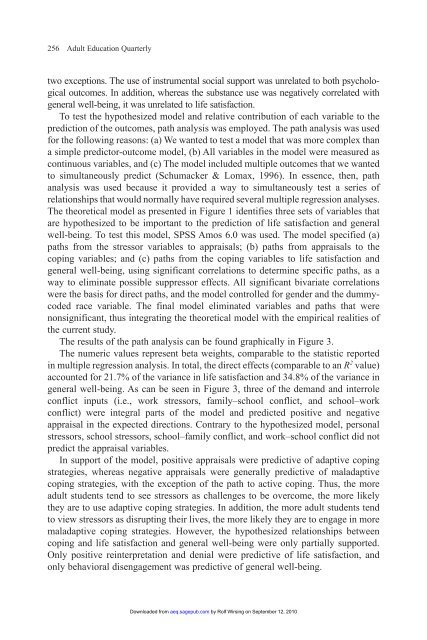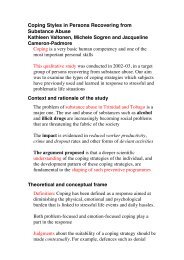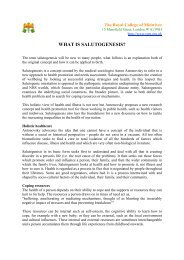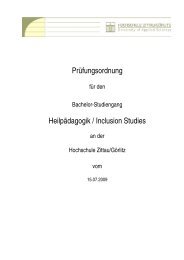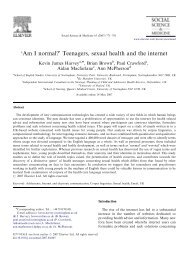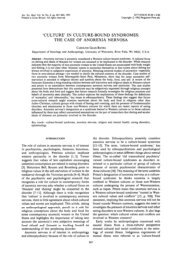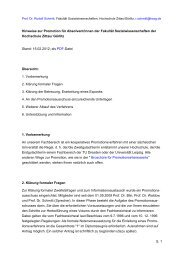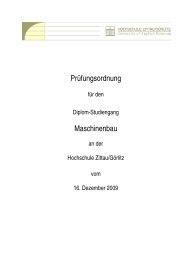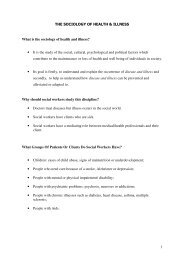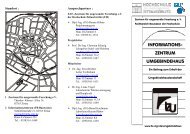Dealing With the Stress of College
Dealing With the Stress of College
Dealing With the Stress of College
Create successful ePaper yourself
Turn your PDF publications into a flip-book with our unique Google optimized e-Paper software.
256 Adult Education Quarterly<br />
two exceptions. The use <strong>of</strong> instrumental social support was unrelated to both psychological<br />
outcomes. In addition, whereas <strong>the</strong> substance use was negatively correlated with<br />
general well-being, it was unrelated to life satisfaction.<br />
To test <strong>the</strong> hypo<strong>the</strong>sized model and relative contribution <strong>of</strong> each variable to <strong>the</strong><br />
prediction <strong>of</strong> <strong>the</strong> outcomes, path analysis was employed. The path analysis was used<br />
for <strong>the</strong> following reasons: (a) We wanted to test a model that was more complex than<br />
a simple predictor-outcome model, (b) All variables in <strong>the</strong> model were measured as<br />
continuous variables, and (c) The model included multiple outcomes that we wanted<br />
to simultaneously predict (Schumacker & Lomax, 1996). In essence, <strong>the</strong>n, path<br />
analysis was used because it provided a way to simultaneously test a series <strong>of</strong><br />
relationships that would normally have required several multiple regression analyses.<br />
The <strong>the</strong>oretical model as presented in Figure 1 identifies three sets <strong>of</strong> variables that<br />
are hypo<strong>the</strong>sized to be important to <strong>the</strong> prediction <strong>of</strong> life satisfaction and general<br />
well-being. To test this model, SPSS Amos 6.0 was used. The model specified (a)<br />
paths from <strong>the</strong> stressor variables to appraisals; (b) paths from appraisals to <strong>the</strong><br />
coping variables; and (c) paths from <strong>the</strong> coping variables to life satisfaction and<br />
general well-being, using significant correlations to determine specific paths, as a<br />
way to eliminate possible suppressor effects. All significant bivariate correlations<br />
were <strong>the</strong> basis for direct paths, and <strong>the</strong> model controlled for gender and <strong>the</strong> dummycoded<br />
race variable. The final model eliminated variables and paths that were<br />
nonsignificant, thus integrating <strong>the</strong> <strong>the</strong>oretical model with <strong>the</strong> empirical realities <strong>of</strong><br />
<strong>the</strong> current study.<br />
The results <strong>of</strong> <strong>the</strong> path analysis can be found graphically in Figure 3.<br />
The numeric values represent beta weights, comparable to <strong>the</strong> statistic reported<br />
in multiple regression analysis. In total, <strong>the</strong> direct effects (comparable to an R 2 value)<br />
accounted for 21.7% <strong>of</strong> <strong>the</strong> variance in life satisfaction and 34.8% <strong>of</strong> <strong>the</strong> variance in<br />
general well-being. As can be seen in Figure 3, three <strong>of</strong> <strong>the</strong> demand and interrole<br />
conflict inputs (i.e., work stressors, family–school conflict, and school–work<br />
conflict) were integral parts <strong>of</strong> <strong>the</strong> model and predicted positive and negative<br />
appraisal in <strong>the</strong> expected directions. Contrary to <strong>the</strong> hypo<strong>the</strong>sized model, personal<br />
stressors, school stressors, school–family conflict, and work–school conflict did not<br />
predict <strong>the</strong> appraisal variables.<br />
In support <strong>of</strong> <strong>the</strong> model, positive appraisals were predictive <strong>of</strong> adaptive coping<br />
strategies, whereas negative appraisals were generally predictive <strong>of</strong> maladaptive<br />
coping strategies, with <strong>the</strong> exception <strong>of</strong> <strong>the</strong> path to active coping. Thus, <strong>the</strong> more<br />
adult students tend to see stressors as challenges to be overcome, <strong>the</strong> more likely<br />
<strong>the</strong>y are to use adaptive coping strategies. In addition, <strong>the</strong> more adult students tend<br />
to view stressors as disrupting <strong>the</strong>ir lives, <strong>the</strong> more likely <strong>the</strong>y are to engage in more<br />
maladaptive coping strategies. However, <strong>the</strong> hypo<strong>the</strong>sized relationships between<br />
coping and life satisfaction and general well-being were only partially supported.<br />
Only positive reinterpretation and denial were predictive <strong>of</strong> life satisfaction, and<br />
only behavioral disengagement was predictive <strong>of</strong> general well-being.<br />
Downloaded from<br />
aeq.sagepub.com by Rolf Wirsing on September 12, 2010


